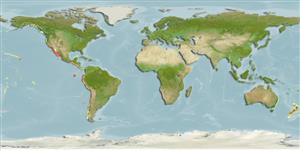Teleostei (teleosts) >
Acanthuriformes (Surgeonfishes) >
Chaetodontidae (Butterflyfishes)
Etymology: Prognathodes: Greek, pro = first, in front of + Greek, gnathos = jaw (Ref. 45335); falcifer: Chaetodon meaning bristle tooth, falcifer meaning scythe-bearer (Ref. 4930).
More on authors: Hubbs & Rechnitzer.
Environment: milieu / climate zone / depth range / distribution range
Ecology
Marine; reef-associated; depth range 10 - 150 m. Subtropical
Eastern Pacific: Santa Catalina Island, southern California, USA to Peru, including the Galapagos Islands.
Size / Weight / Age
Maturity: Lm ? range ? - ? cm
Max length : 15.0 cm TL male/unsexed; (Ref. 9286)
Usually solitary. Found in rocky, boulder strewn areas (Ref. 5227). Close relatives are known to pinch off and eat tube feet of sea urchins and other echinoderms. Also feed on crustaceans, worms and other small invertebrates (Ref. 4930). Because they live in relatively deeper waters, they are seldom collected, thus, rarely seen in the aquarium trade (Ref. 4930). Oviparous (Ref. 205). Form pairs during breeding (Ref. 205).
Life cycle and mating behavior
Maturity | Reproduction | Spawning | Eggs | Fecundity | Larvae
Form pairs during breeding (Ref. 205).
Allen, G.R., 1985. Butterfly and angelfishes of the world. Vol. 2. 3rd edit. in English. Mergus Publishers, Melle, Germany. (Ref. 4858)
IUCN Red List Status (Ref. 130435)
Threat to humans
Harmless
Human uses
Aquarium: commercial
More information
ReferencesAquacultureAquaculture profileStrainsGeneticsElectrophoresesHeritabilityDiseasesProcessingNutrientsMass conversion
Tools
Special reports
Download XML
Internet sources
Estimates based on models
Preferred temperature (Ref.
123201): 14.2 - 22.9, mean 16.9 °C (based on 40 cells).
Phylogenetic diversity index (Ref.
82804): PD
50 = 0.5002 [Uniqueness, from 0.5 = low to 2.0 = high].
Bayesian length-weight: a=0.02239 (0.01117 - 0.04486), b=3.02 (2.85 - 3.19), in cm total length, based on LWR estimates for this (Sub)family-body shape (Ref.
93245).
Trophic level (Ref.
69278): 3.3 ±0.34 se; based on food items.
Resilience (Ref.
120179): High, minimum population doubling time less than 15 months (Preliminary K or Fecundity.).
Fishing Vulnerability (Ref.
59153): Low vulnerability (10 of 100).
Nutrients (Ref.
124155): Calcium = 64.6 [28.6, 132.6] mg/100g; Iron = 0.852 [0.454, 1.592] mg/100g; Protein = 19.3 [18.0, 20.5] %; Omega3 = 0.213 [0.111, 0.406] g/100g; Selenium = 21 [9, 45] μg/100g; VitaminA = 29.5 [6.8, 126.0] μg/100g; Zinc = 0.963 [0.587, 1.498] mg/100g (wet weight);
